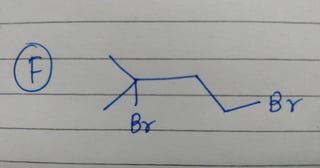For some reason, I thought this question is going to be closed eventually. The main reason is the title asking "Is there a reaction involving alkene formation from diazomethane?" but the post of the question says something else. And, then, OP has given his/her own answer, but that did not provide an answer to the question in the title. Thus, for benefit of education, I'd try to solve so many questions within OP's post. By the way, the answer to the question in the title is yes or no. Yes, only if ketene formation is counted as an alkene formation. Otherwise, it is definitely 'no.'
Let's see OP's posted question(s) step by step:
- The compound $\bf{A}$ is optically active, which have a formula of $\ce{C_nH_{2n+1}DO}$. Since, the number of unsaturation within the molecule is zero, we can conclude that the molecule is an alcohol or an ether. The positive blue color test by Victor-Mayer test tell us it is a secondary alcohol. The positive iodoform test tells it has $\ce{CH3CHOH}$- function. Thus, the structure given for is partially correct. Why partially? Because OP has ignored the next step to produce dehydroxylated product $\bf{B}$, which have molar mass of $\pu{71 g mol-1}$. Thus, the deuterium ion in $\bf{A}$ can not leave the molecule fully or partially. The structure given in $\bf{A}$ would leave the molecule at least partially if it is subjected to dihydroxylation. Therefore best structure for $\bf{A}$ would have been:

When $\bf{A}$ is subjected to dihydroxylation, it'd give two alkene compounds (cis and trans), both of which have molar mass of $\pu{71 g mol-1}$. My version of the structure $\bf{A}$ should not undergo deuterium exchange under reaction conditions so that deuterium remains 100%. The next trick is when subjected to pyrolysis after esterification of $\bf{A}$, it didn't say the (major)product would be optically active. To me, there are two different $\beta$-protons, either of which can be eliminated during the pyrolysis as shown in the scheme (Ref.1 & 2):

I assume, the "major" alkene must be optically active $\bf{D}$ because other path gave the product we received before in a different path. This optically active $\bf{D}$ would undergoes reaction to give an allyl bromide $\bf{E}$ as explain in the OP's answer. But unlike OP's structure, my product is chiral (although it gave a racemic mixture). All these and other structures are summarized in following scheme:

Only thing missing here is the Wurtz product from the chiral $\bf{F}$, which I belive dimerized to give a six-membered product due to steric hindrance of bulky $\ce{Br}$ atom.
References:
- Charles D. Hurd and Ford H. Blunck, "The Pyrolysis of Esters," J. Am. Chem. Soc. 1938, 60(10), 2419–2425 (ODI: https://doi.org/10.1021/ja01277a035).
- William J. Bailey and Robert Barkley, Jr., "Pyrolysis of Esters. V. Mechanism of 1,4-Elimination," J. Org. Chem. 1956, 21(3), 328–331 (ODI: https://doi.org/10.1021/jo01109a017).











